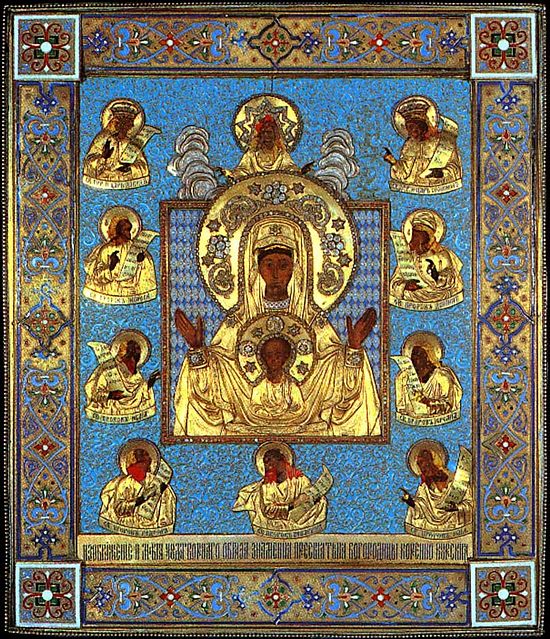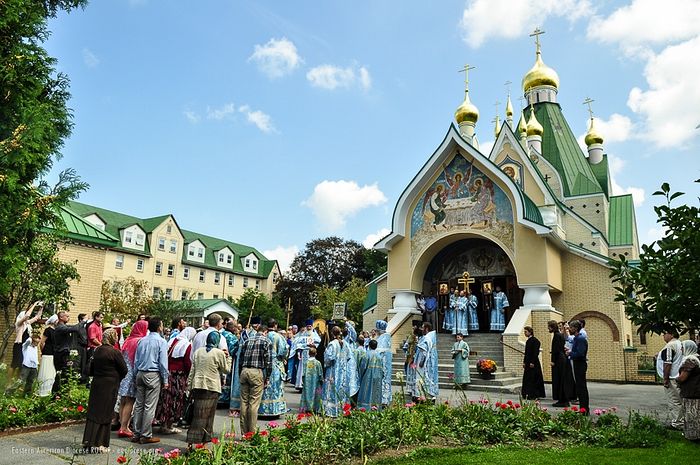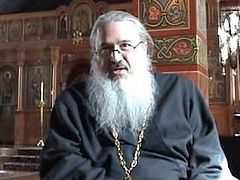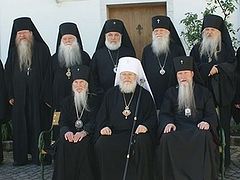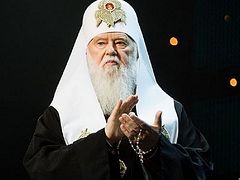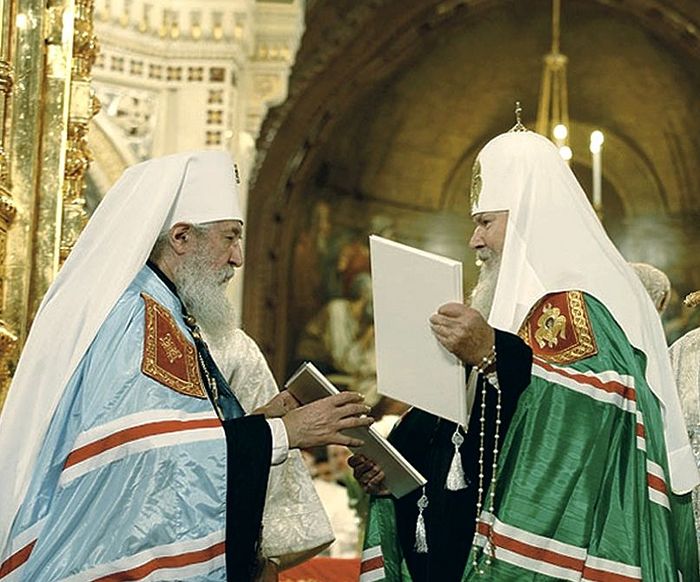 Metropolitan Laurus the head of the Russian Orthodox Church Outside of Russia and Patriarch Alexius II. Photo: Press Service of the Patriarch of Moscow and All Russia
Metropolitan Laurus the head of the Russian Orthodox Church Outside of Russia and Patriarch Alexius II. Photo: Press Service of the Patriarch of Moscow and All Russia Prayerfully empathizing with the Ukrainian Orthodox Church, we extend a brotherly kiss to the podvig of witness of His Beatitude Metropolitan Onouphry of Kiev and All Ukraine, the archpastors, clergymen and the entire faithful flock of the canonical Ukrainian Orthodox Church, which is recognized by all the Local Orthodox Churches except for the one which entered into communion with schismatics and “self-sanctifiers,” and which yesterday blasphemously held a funeral service for the cremated remains of a police dog in their Detroit, MI, church.
We who are located in distant USA, fervently pray, relying on the mercy of God, and prepare to celebrate the feast day of the Kursk Root Icon of the Mother of God "of the Sign," (November 27/December 10). This is one of the oldest icons of the Russian Orthodox Church. Praying before this holy relic together with his parents, the future St. Seraphim of Sarov was healed. This icon was one of several before which Kutuzov prayed before the Battle of Borodino. St. John (Maximovich), the great archpastor, man of prayer and miracle-worker of the Russian diaspora, died holding this icon in his hands. Revolutionaries attempted to destroy this icon, placing a bomb beside it, but despite the fact that the church in which it was suffered significant damage, the miracle-working image remained intact and undamaged, and even the glass of its frame it did not shatter. In 1920, the Kursk-Root Icon forever left Russia. Over the course of decades, it has been venerated as the Hodigitria, the “Shower of the Way,” of the Russian emigration. An expanded session of the Synod of Bishops of the Russian Church Abroad will be held around its feast day.
I recall how in 2009, before its first return visit to its homeland, it was necessary to clean the icon, carry out some restorative work and make a detailed description of the condition of this miraculous image. The ancient oklad had to be carefully removed. I was interested to see if there was still a crack in it, as described by the chronicler of the 13th century, who wrote that the icon, which was hacked in two by Tatars, miraculously grew back together when a priest held the two pieces together, though a crack remained down the middle, attesting to the fact that it was cut in two. And so, everyone who participated in this work saw the “scar” on the icon, which still remains from those times.
Some believe that what happened in the 13th century was a prophesy that a tragic division would take place within the Russian Orthodox Church, and that the Mother of God would reunite what seemed irreconcilable. And just as the two parts of the Kursk-Root Icon miraculously grew together again in the hands of the priest, so did the two parts of the once-united Russian Orthodox Church, temporarily divided for political reasons into the part in the Fatherland and the part abroad, reunite in the early 21st century in the hands of His Holiness Patriarch Alexei II and Metropolitan Laurus of blessed memory.
In our time, some have the audacity to compare the Russian Church Abroad to the so-called “Philaretites” and “self-sanctifiers.” Unlike Philaret Denisenko, the founders of the Russian Church Abroad had not been condemned by an ecclesiastical tribunal, deprived of their clerical ranks or anathematized. On the contrary, the Act of Canonical Communion, confirmed by both Synods of the united Russian Church and signed by the aforementioned Primates, states: “That the Russian Orthodox Church Outside of Russia, conducting its salvific service in the dioceses, parishes, monasteries, brotherhoods, and other ecclesiastical bodies that were formed through history, remains an indissoluble, self-governing part of the Local Russian Orthodox Church” which demonstrates the recognition by the Church in the Fatherland of the historical path and canonicity of the Russian Church Abroad, established on the basis of Ukase No. 362 of 1920 of Holy Patriarch Tikhon the Confessor. This decision by the Holy Synod, headed by Patriarch Tikhon, served as a categorical requirement of the conciliar rule of those dioceses and parts of the Church which found themselves torn from their central administrative organ.
It is interesting to note that even after the coerced Patriarchal ukase on the dissolution of the Supreme Ecclesiastical Administration abroad on May 5, 1922, St. Tikhon the Confessor, under house arrest, continued to maintain correspondence with archpastors abroad. This is attested to by the establishment of the Diocese of Harbin (China) of the Russian Church Abroad. That year, Archbishop Mefody(Gerasimov) of Orenburg, who found himself in China, sent St. Tikhon a report on the need to establish a new diocese within the jurisdiction of the Russian Orthodox Church Outside of Russia, making use of a trip from Harbin to Moscow of a trustworthy and devoted Russian Orthodox man. Because of the searches conducted upon entry into the USSR of passengers from Harbin, the report was written on a small slip of paper in very small print by a calligraphically-talented choir director in Harbin; it was then sewn into the insole of a boot of the traveler. His Holiness Patriarch Tikhon sent a telegram in response to Archbishop Mefody containing the words “I bless.” In an announcement by the East China Railroad Administration about Archbishop Mefody, there is no mention of his appointment by the Supreme Ecclesiastical Authority (the Church Abroad), only of the blessing of Patriarch Tikhon.
Two days before the ukase of May 5, 1922, Patriarch Tikhon spoke with a Mr. Colton, an American representative of the YMCA. To his request to appoint Metropolitan Platon to the USA diocese, St. Tikhon responded that he can only make a recommendation to be communicated to the refugee bishops who administered matters abroad. So if the aforementioned ukase [of the dissolution of the Supreme Ecclesiastical Authority] corresponded with the desire of St. Tikhon and his Synod of Bishops, this conversation would have been completely different.
On September 12, 1926, Metropolitan Sergei (Stragorodsky), the future patriarch, sent the following response to the request of the bishops abroad to judge the matter of Metropolitan Evlogy(Georgievsky): “My dear Hierarchs, you ask me to be a judge in a matter about which I know nothing. I don’t know who comprises your Synod and Council and what their authorities are. I don’t know the subject of the disagreements between the Synod and Metropolitan Evlogy. Clearly, I cannot be a judge in the matter between you. Your letter leads me to pose a general question: Can the Moscow Patriarchate guide the ecclesial life of Orthodox emigres when we have practically no contact? I think that the expediency of the work of the Church demands that through common consent you establish for yourselves a central organ of ecclesiastical administration, with enough authority to resolve all misunderstandings and disobedience, without turning to our support, for there will always be a basis to suspect the earnestness of our instructions or dismiss them as being under-informed: Some will recognize them, others will not, for instance, Metropolitan Evlogy, as you write, refers to the ukase of His Holiness the Patriarch of 1922, and you the ukase of 1920.”
From the above we see that the persecuted Church deemed it necessary to preserve the Synod of Bishops of the Russian Orthodox Church Outside of Russia.
The Local Orthodox Churches never recognized either Philaret Denisenko, his followers or the self-sanctifiers. Moreover, at the recent Council of Bishops of the Serbian Orthodox Church it was noted that “the Patriarchate of Constantinople made a canonically-unfounded decision to rehabilitate as bishops and recognize the two leaders of the schismatic groups in Ukraine, Philaret Denisenko and Makary Maletich…”
In the 1920’s, the Serbian Orthodox Church opened wide the doors to the Russian refugee bishops and their clergymen and exiled flock. His Holiness Patriarch Dimitrij offered them warm hospitality, granting the Orthodox communities, their hierarchs and clerics the broadest autonomy, with the full support of the government of Yugoslavia. His successor, Patriarch Varnava, addressing the Russian refugees during a sermon, said: “Among you is a great hierarch, His Eminence Metropolitan Anthony (Khrapovitsky), who is an adornment of the Ecumenical Orthodox Church. His is a lofty mind, similar to the first hierarchs of the Church of Christ in early Christianity.”
I remember how in the early 1990’s, Patriarch Pavle of Serbia, a great ascetic of our time, while visiting the Cathedral of the Mother of God “Joy of All Who Sorrow” in San Francisco, made a prostration before the crypt of St. John (Maximovich), who was not yet canonized by the Russian Church Abroad, sang a common troparion to the hierarch, and called Archbishop Anthony (Medvedev), who met the Serbian Primate with tears in his eyes, “a great man of prayer.”
To be honest, I never heard from authoritative representatives of the Local Orthodox Church any such words with regard to Philaret, his followers or the self-sanctifiers.
Thanks to the work of Metropolitan Anastassy (Gribanovsky), the second Primate of the Russian Church Abroad, we were able to preserve the legacy of the Mother Church in the Holy Land and to reestablish the episcopacy of the Jerusalem Patriarchate. The latter is a well-known fact. By the way, the clergymen of the Russian Ecclesiastical Mission in Jerusalem of the Russian Church Abroad always serve on antimensia consecrated and signed by the Patriarchs of Jerusalem, and the archpastors, clergymen and laity of our Church have a blessing to commune at the Life-Bearing Sepulcher of the Lord and other holy sites, a privilege of which neither the Philaretites nor the self-sanctifiers can boast.
One can proffer many other examples and attestations which have been written about in detail by clergymen and historians, which prove that the reestablishment of unity within the Russian Orthodox Church in 2007 was in no fashion a “legalization of schism,” but in fact mutual acceptance, reconciliation within the Russian Orthodox Church and the renewal of the fullness of fraternal communion. Yes, there was repentance on the part of clerics who during the years of division went from one jurisdiction to another without decrees of ecclesial release. They sent their letters of repentance to their former ruling bishops, received forgiveness from their archpastors and their clerical ranks were acknowledged.
In short, overcoming the long division, AV Kartashev wrote about in his article “The Unification of Churches in the Light of History”: “Two parts of the Church in living grace are once again united externally and apparently, obviously during their quarrels never having ceased to be invisibly united within the bosom of the Holy Spirit, the Life-Creating Church. This is not a ‘unia,’ and not an ‘annexation’ but reconciliation.”
Today, as we approach the celebration of the Kursk-Root Icon of the Mother of God "of the Sign,” and venerating this ancient, wondrous image, we turn to Her Who is depicted and pray to Her, naming Her the “unassailable wall,” that is, our protection, and a “fountain of miracles.” Around the canonical Ukrainian Orthodox Church, around us and all over the world we continue to experience hostility, all sorts of divisions and resistance, and for this reason we need the prayerful intercession of the Mother of God, so that She does not cease to direct Her most-pure hand, as is depicted in the icon of the type “of the Sign,” praying for His Beatitude Metropolitan Onouphry, the archpastors, pastors, all of us and for the whole world, so that we may preserve peace, the wisdom of the Holy Fathers, ecclesial sobriety and calmness. Amen.

